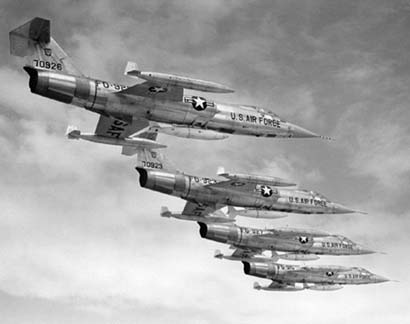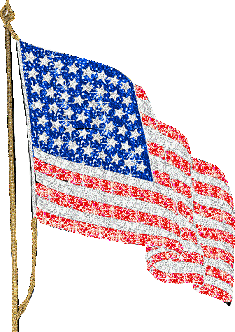
FALL IN to the FReeper Foxhole!

Good Friday Morning Everyone
If you would like added to our ping list let us know.


We had 40-50 MPH winds yesterday. Severe T-Storms in Northern Oklahoma. It's calm here now.


Waco CG4A Troop Transport Glider

|
Air Power |
History
Lockheed F-104 Starfighter was the last of the day fighters, a high-performance supersonic interceptor aircraft capable of high speeds and climb rates. In this role the Starfighter served for only a short time, and was generally disliked by the Air Force who were looking for ever larger and more all-round designs. The Starfighter gained a second lease on life in the 1960s when it was selected as the basis for a high-speed tactical fighter by a European commission. Many served in this role into the 1980s.
In 1951 "Kelly" Johnson, chief engineer at Lockheed's Skunk Works, visited Korea in December 1951 and talked to fighter pilots about what sort of plane they wanted. At the time the US pilots were meeting the MiG-15 in their F-86's, and while the MiG was being flown by poorer pilots, the plane was otherwise in most ways superior to the much larger and more complex American design. The almost universal agreement was that the trend to larger and more sophisticated designs was a bad one, and that what they really wanted was a small and simple aircraft with excellent performance.
On his return to the US, Johnson immediately started the design of just such an aircraft. In March his team was assembled and they studied a number of aircraft designs ranging from tiny designs at 8,000lbs, to fairly large ones at 50,000lbs. In November 1952 a follow-on study started, the lessons learned from the earlier designs being used to eventually result in the Lockheed L-246, of about 12,000 lbs. The 246 remained essentially identical to the Starfighter as eventually delivered.
The design was presented to the Air Force in November 1952, and they were interested enough to create a new proposal and send it out to several companies to participate. Three additional designs were received, the Republic AP-55, an improved version of its prototype XF-91 Thunderceptor, the North American NA-212 which would eventually evolve into the F-107, and the Northrop N-102 Fang, a new J79-powered design. Although all were interesting, Lockheed had an insurmountable lead, and was granted a development contract in March 1953.
Work progressed quickly, with a mock-up ready for inspection at the end of April, and work starting on two prototypes late in May. At the time the J79 engine was not ready, so both prototypes were designed to use the Wright J65 engine instead, a licensed version of the Armstrong Siddeley Sapphire. The first prototype was completed by early 1954, and started flying in March. The total time from design to flying was about two years, unheard of even then, let alone today when ten to fifteen years is more typical.
Design
In order to achieve the kind of performance the Lockheed engineers wanted, the Starfighter used what was then a radical design for the wing. To reduce drag in the transonic speed range, a wing should be as thin as possible, and have as long a chord (front to back span) as it can. This reduces the rate of the change in the airflow over the wing, and reduces wave drag, cause of the so-called sound barrier. The vast majority of planes of the era (and today) used the swept wing planform, which fools the air into thinking the wing has a longer chord (by the sine of the sweep angle) while still allowing for a wing that was thick enough to hold control lines, gear and fuel.
The Lockheed decided to dispense with the swept wing, and instead simply make a very thin, long chord wing. The wing was so thin that there was no room inside for landing-gear or fuel, both of which were contained in the rear of the fuselage instead. The trade-off in this design was excellent lift-to-drag ratio for most conditions, except in high angle of attack situations (like combat) where it would have very high drag. The wing also had 10 degrees of negative dihedral (anhedral) in order to combat roll coupling, instead of using an active system like most designs of the era.
Another side effect of the small wing was very high landing speed, so the design incorporated a system known as blown flaps, in which air from the engine was blown over the rear portion of the wing when the flaps are down, dramatically increasing lift. The system was very popular at the time, but would later prove to be a serious maintenance problem on all the designs that tried it.
The fuselage itself was very long and skinny to achieve a high fineness ratio, key to high performance in the supersonic speed range. With the gear and fuel all in this small fuselage, the plane was left with a very short range and limited ability to carry equipment and armament. It appeared a poor dogfighter, its small wings limiting maneuverability, and it had problems in operating in rough, rainy weather. The plane difficult to fly, and many crashes occurred (292 during the long career of the F-104).
Production
It was produced in two major versions. Armed with a six-barrel 20mm M61 Vulcan cannon it served as a tactical fighter and, with additional heat-seeking AIM-9 Sidewinder missiles, as a day-night interceptor. On May 18, 1958, an F-104A set a world speed record of 1,404.19 mph, and on December 14, 1959, an F-104C set a world altitude record of 103,395 feet. The Starfighter was the first aircraft to hold simultaneous official world records for speed, altitude and time-to-climb.
The USAF procured only 296 Starfighters in one- and two-seat versions. The Starfighter became obsolete in Air Force inventory as the USSR moved to replace long range bombers with ICBMs. The plane appeared more useful to NATO countries, and 2,578 F-104s were built in the U.S. and abroad under the military aid program for various nations, including Canada, West Germany, Italy, Norway, the Netherlands, Belgium, Denmark, Greece, Turkey, Spain, Pakistan, the Republic of China (Taiwan) and Japan. In Germany, the minister of defence Franz Josef Strauss almost had to resign, because of the massive procurement of Starfighters and the death of around 115 pilots in accidents (allegations ranged from "a purely political deal" to bribery). This episode also inspired a rock concept album by Robert Calvert of Hawkwind, called Captain Lockheed and the Starfighters.
Nicknames
"Missile With A Man In It", "Widowmaker", "Flying Coffin".
Specifications:
Manufacurer: Lockheed
Primary Function: Fighter
Contractor: Lockheed Aircraft Corporation
Crew: One - F-104b had Two (pilot & student)
Powerplant: One General Electric J79-GE-3B at 9,600 lb (4,354 kg) each
Dimensions:
Length: 54 feet 8 inches (16.6 m)
Wingspan: 21 feet 9 inches (6.6 m)
Height: 13 feet 5 inches (4.0 m)
Weights: Empty: 13,384 lb (6,071 kg) / Maximum Takeoff: 25,840 lb (11,271 kg)
Performance :
Speed: 1,450 mph (Mach 2.2) at 35,000 ft.
Ceiling: 64,795 ft (19,750 m)
Range: 730 miles (1,175 km)
Armaments:
M-61 Vulcan 20mm cannon;
4,000 lbs of bombs under the wings
two AAM-N-7 Sidewinder missiles on tips









To all our military men and women, past and present,
THANK YOU for serving the USA!

No, I didn't run away from home. LOL! I've been down with my bum back....again. Will I ever learn NOT to wrestle with carpet cleaners? Probably not. hehe!
I didn't want you to think I'd forgotten ya! NO WAY! Just haven't been able to spend time upright for a couple of days. Still limited now but wanted to say "hello" while I could sit up for a few minutes.
I hope everyone is doing great! *HUGZ* all 'round.